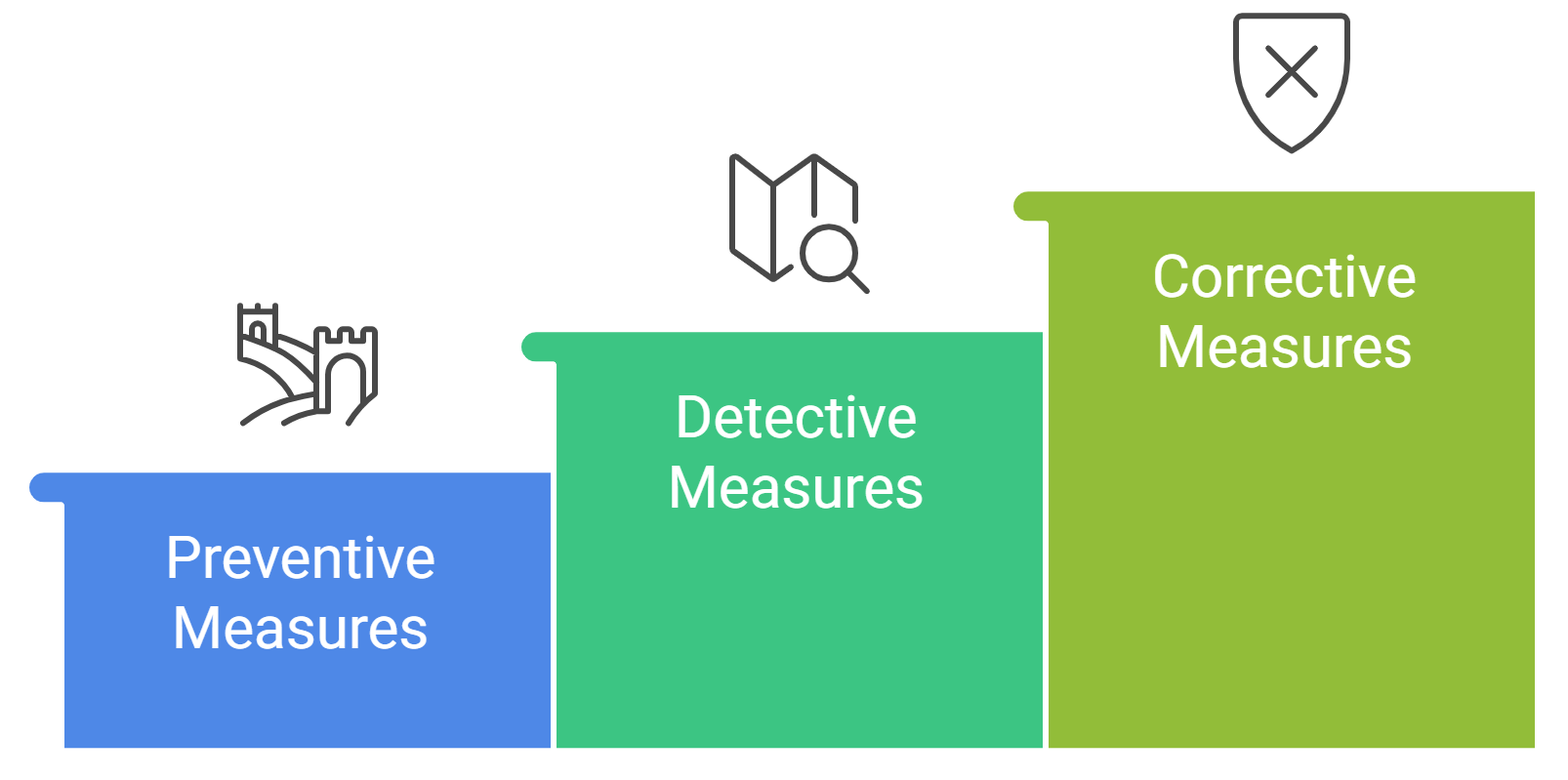Imagine your house. You lock your doors, install an alarm system, and keep a fire extinguisher handy. Each of these actions is a way to protect your home from risks—whether it’s theft, fire, or any unexpected event. Just like protecting your home, organizations need to protect their digital assets—like data, applications, and networks—from cyber threats. This is where security controls come into play.
Security controls are measures put in place to prevent, detect, and correct problems or attacks in a system. They act like safeguards that keep data safe, help spot any unusual activity, and fix problems when they happen. In this blog, we will explore the three main types of security controls: Preventive, Detective, and Corrective, with simple explanations and real-world examples.
-
Preventive Controls: Stopping Problems Before They Happen
Preventive controls are like the first line of defense. Their goal is to stop security incidents from happening in the first place. Think of them as precautions or safety measures.
Examples of Preventive Controls:
- Passwords and Authentication: Just like a key to your house, passwords keep unauthorized people out of your system.
- Firewalls: These are like guards at the gate of your network, blocking harmful traffic.
- Access Control: Giving employees only the access they need prevents accidental or intentional misuse of sensitive data.
- Encryption: Scrambling your data so that even if someone steals it, they can’t read it without the right key.
- Security Policies: Rules like “Do not share passwords” or “Use secure Wi-Fi” guide employees to act safely.
Why Preventive Controls Are Important:
Preventive controls are crucial because stopping a problem before it happens is always better than fixing it later. They reduce the risk of cyber attacks and data breaches, protecting both the organization and its customers.
-
Detective Controls: Spotting Problems Quickly
Even with the best preventive measures, some threats can still slip through. This is where detective controls come in. They identify and alert you to problems, so action can be taken quickly. Think of them as alarms and sensors in your house—they don’t stop a burglar but let you know when something is wrong.
Examples of Detective Controls:
- Intrusion Detection Systems (IDS): Monitors your network for suspicious activity and alerts you if something unusual happens.
- Log Monitoring: Keeps a record of user activity and system events to spot abnormal behavior.
- Security Cameras and CCTV (in a physical sense): Captures events so you can investigate later.
- File Integrity Monitoring: Checks if important files have been changed or tampered with.
- Audit Trails: Tracks who did what and when, helping detect fraud or unauthorized access.
Why Detective Controls Are Important:
Detective controls help organizations catch issues early, preventing minor problems from becoming major disasters. Quick detection means faster response, less damage, and fewer costs.
-
Corrective Controls: Fixing Problems and Reducing Damage
Sometimes, even preventive and detective measures fail. When this happens, corrective controls step in to fix the problem, recover lost data, and prevent future occurrences. Think of them as emergency responders or repair crews.
Examples of Corrective Controls:
- Data Backups and Recovery: If files are lost or corrupted, backups help restore them quickly.
- Patching Vulnerabilities: Fixing software bugs that could be exploited by attackers.
- Incident Response Plans: Step-by-step procedures for handling security breaches.
- System Reconfiguration: Changing settings or permissions to stop further issues.
- Anti-Malware Removal Tools: Cleaning infected systems after a virus or malware attack.
Why Corrective Controls Are Important:
Corrective controls minimize the damage caused by security incidents. They help organizations recover quickly, restore trust, and learn from mistakes to improve future defenses.
How the Three Controls Work Together
Preventive, detective, and corrective controls are not separate silos; they work together like a complete security system. Let’s take an example:
- A company installs strong passwords and firewalls (preventive).
- An IDS system monitors the network for unusual activity (detective).
- In case a malware attack happens, data backups and incident response plans kick in to restore systems (corrective).
This combination creates a layered defense, making it much harder for attackers to succeed.
Conclusion
In today’s digital world, cyber threats are everywhere. Organizations face risks like data breaches, malware attacks, phishing, and insider threats. Security controls—preventive, detective, and corrective—act as the backbone of any organization’s cybersecurity strategy.
- Preventive controls stop attacks before they happen.
- Detective controls spot problems quickly.
- Corrective controls fix issues and help recover from attacks.
By understanding and implementing these controls, organizations can protect sensitive information, reduce risk, and respond effectively to incidents. For students preparing for SOC interviews, knowing these three types of controls is essential—it’s one of the most frequently asked topics and forms the foundation of cybersecurity knowledge.
Remember, just like protecting your home, a layered approach with prevention, detection, and correction is the key to staying safe in the digital world.





